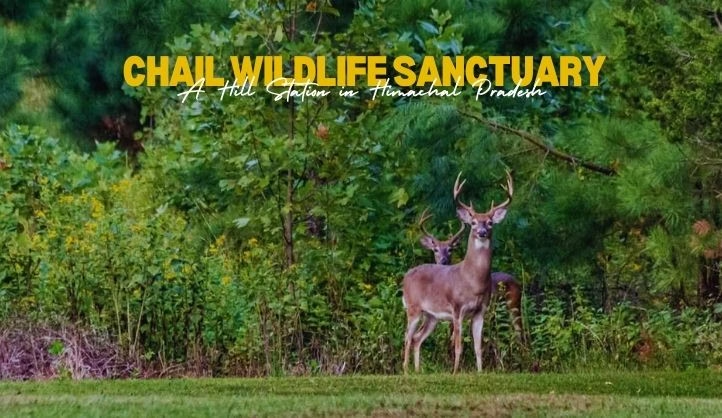Himachal Pradesh, known for its breathtaking landscapes and rich biodiversity, is home to several wildlife sanctuaries. One such hidden gem is the Chail Wildlife Sanctuary, nestled in the serene hills of the state. Located in the Chail hill station which lies in Solan district, this sanctuary is a haven for wildlife enthusiasts and nature lovers. It boasts a variety of flora and fauna, offering visitors a unique experience. If you are looking for an offbeat destination to explore the wilderness, Chail Wildlife Sanctuary should be on your list.
History and Significance
Chail Wildlife Sanctuary was established in 1976 to protect the rich biodiversity of the region. Before its declaration as a sanctuary, it served as the hunting ground for the Maharaja of Patiala. The Maharaja, after being exiled from Shimla by the British, made Chail his new home and converted it into his personal hunting reserve. Over time, as conservation awareness grew, the area was designated a protected sanctuary to preserve its wildlife. Today, the sanctuary plays a crucial role in maintaining the ecological balance of the region and serves as a haven for several endangered species.
Location and How to Reach
Chail Wildlife Sanctuary is situated in the Solan district of Himachal Pradesh, around 45 km from Shimla and 60 km from Solan. The sanctuary is well connected to major cities via road, rail, and air transport.
- By Air: The nearest airport is Shimla (Jubbarhatti Airport), about 60 km away. Taxis and buses are available to reach Chail from the airport.
- By Train: The closest railway station is Kalka, approximately 80 km away. Kalka is well connected to major cities like Delhi and Chandigarh. From Kalka, one can take a toy train to Shimla or hire a taxi to Chail.
- By Road: Chail is well connected by road to major cities like Shimla, Solan, and Chandigarh. Regular bus services operate from these cities, and private taxis are also available for hire.
Flora and Fauna
The sanctuary is home to diverse wildlife species and a rich variety of plants, making it an essential ecological hotspot.
Flora
The Chail Wildlife Sanctuary is covered in dense forests of oak, pine, deodar, and rhododendron ( Buransh) trees. These towering trees provide a lush green canopy, making the area a serene and picturesque environment. In addition, the undergrowth consists of a variety of shrubs and medicinal plants, many of which are used in traditional Himalayan medicine.
Fauna
Chail Wildlife Sanctuary provides shelter to a wide range of animals, some of which are endangered or rare. The sanctuary is home to:
- Leopards – These elusive predators roam the dense forests but are rarely spotted by visitors.
- Himalayan Black Bears – These powerful creatures are found in the higher altitudes of the sanctuary.
- Ghorals (Mountain Goats) – Ghorals are agile mountain animals often seen scaling steep terrains.
- Wild Boars – These hardy animals thrive in the dense foliage of the sanctuary.
- Barking Deer – Their distinctive barking sound is often heard in the quiet forests.
- Langurs – These playful primates swing between the trees and are commonly seen in the region.
Apart from mammals, the sanctuary is also home to an extensive variety of birds. Birdwatchers can spot species such as:
- Khalij Pheasant – A beautifully colored bird native to the region.
- Cheer Pheasant – A rare and endangered species.
- Golden Eagles – These majestic birds of prey soar high above the forests.
- Himalayan Monals – Himalayan Monals is the state bird of Uttarakhand and the former state bird of Himachal. It is known for its vibrant plumage.
Best Time to Visit
The best time to visit Chail Wildlife Sanctuary is March to October when the weather remains pleasant, making it ideal for exploring the sanctuary. During these months, the flora is in full bloom, and wildlife sightings are more frequent.
- Spring (March to May): This season is perfect for trekking and birdwatching as the forests are lush and filled with activity.
- Monsoon (June to September): The sanctuary receives moderate rainfall, enhancing its natural beauty but making some trails slippery.
- Autumn (October to November): A great time for photographers, as the forest takes on warm hues.
- Winter (November to February): The sanctuary experiences chilly temperatures, and some areas may receive snowfall. While this is not the best time for wildlife spotting, it offers a unique snowy landscape.
Activities to Do in Chail Wildlife Sanctuary
- Wildlife Safari – A guided safari allows visitors to explore the dense forests and observe wildlife up close.
- Trekking – Several trails pass through the sanctuary, offering adventure lovers a chance to trek amidst nature.
- Bird Watching – With its rich avian diversity, Chail is a paradise for birdwatchers.
- Photography – The sanctuary’s picturesque landscapes provide excellent photography opportunities.
- Camping – Outdoor enthusiasts can camp in designated areas near the sanctuary for an immersive experience.
Nearby Attractions
- Chail Palace – A historical palace known for its stunning architecture and royal heritage.
- Kali Ka Tibba – A famous temple perched on a hilltop, offering breathtaking panoramic views.
- Sadhupul – A quaint riverside spot perfect for picnics and relaxation.
- Shimla – The capital of Himachal Pradesh, located a short drive away, is known for its colonial charm and bustling markets.
Accommodation Options
There are several accommodation options available near the sanctuary, catering to all budgets. Some recommended places include:
- Chail Palace Hotel – A heritage property with a royal ambiance.
- Jungle Stay Camps – Offers an immersive experience for nature lovers.
- Guesthouses and Homestays – Provide a comfortable stay with local hospitality.
Conservation Efforts
The government and various environmental organizations are working towards preserving Chail Wildlife Sanctuary. Initiatives include:
- Strict Anti-Poaching Laws – Ensuring the protection of endangered species.
- Afforestation Programs – Planting trees to maintain ecological balance.
- Wildlife Monitoring – Regular tracking of animal populations to study their behavior and habitat conditions.
Conclusion
Chail Wildlife Sanctuary is a must-visit destination for those who love nature and wildlife. Whether you are an adventure enthusiast, a birdwatcher, or someone looking for a peaceful retreat, this sanctuary has something for everyone. Plan your visit and immerse yourself in the untouched beauty of Himachal Pradesh!
FAQs About Chail Wildlife Sanctuary
1. Is Chail Wildlife Sanctuary safe for tourists?
Yes, the sanctuary is safe for visitors. However, it is advised to follow guidelines and avoid disturbing the wildlife.
2. Do I need permission to visit the sanctuary?
Yes, visitors may need an entry permit, which can be obtained from the forest department.
3. Can we camp inside the sanctuary?
Camping is allowed in designated areas near the sanctuary but not inside the core wildlife zones.
4. What is the best way to explore the sanctuary?
A guided tour or wildlife safari is the best way to explore the sanctuary and spot animals.
5. Is Chail Wildlife Sanctuary suitable for families?
Yes, it is a great destination for families, nature lovers, and adventure seekers.





